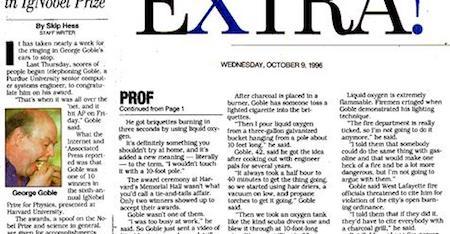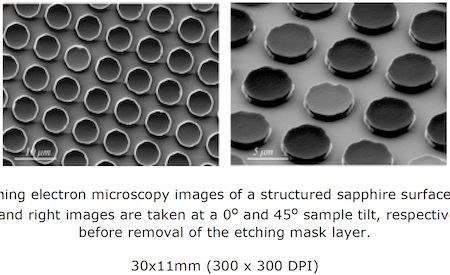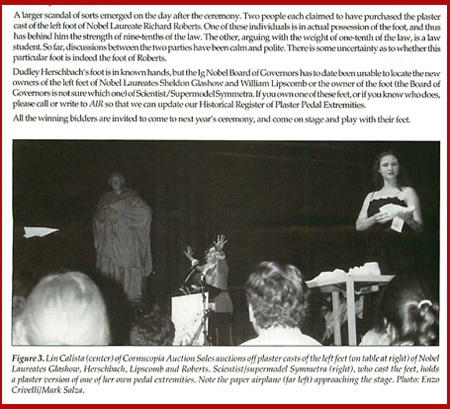Marc Abrahams's Blog, page 167
November 5, 2018
“Curiosos y absurdos descubrimientos son celebrados” [VIDEO]
“Curiosos y absurdos descubrimientos son celebrados en los premios Ignobel” —Efecto Naim explains the Ig Nobel Prizes:


Of Mice, Men and Scrumpox
Herpes gladiatorum is caused by a highly infectious version of the human herpes simplex virus type 1 (HSV-1) and is associated with high physical-impact sports – it frequently plagues rugby players (who know it as ‘Scrumpox’), along with Judo participants and Sumo Wrestlers.
For details of the latter, a paper by Fumihiko Ban, Satoe Asano, Shigeru Ozawa, Hiroyuki Eda, James Norman, William G. Stroop and Kazuo Yanagi in the Journal of General Virology, 89 (Pt 10): 2410-5 · November 2008, explains that :
“The pathogenic properties of HSV-1 variants in mice and professional sumo wrestlers were examined here.”
“The frequent severe skin damage of sumo wrestlers may impair subcutaneous nerve cells and the strong physiological and mental stress resulting from their hard practice regime may affect their immunological status.”
[ Research research by Martin Gardiner ]

November 3, 2018
Ciencia Colada takes an Ig Nobel ramble
Ciencia Colada takes a two-part ramble, in Spanish, through some history of the Ig Nobel Prizes and glances, a bit, at some of the other activities of Improbable Research (including a few of the Improbable Research Collection videos):
Los Premios Nobel Alternativos. Parte 1
Los Premios Nobel Alternativos. Parte 2

November 2, 2018
Mental Health Effects Caused by Red Imported Fire Ant Attacks? [research study]
Stings by imported red fire ants don’t (though maybe do) induce some mental health problems in humans—the yes or no of it depending on one’s inclination and interpretation—suggests this study:
“Mental Health Effects Caused by Red Imported Fire Ant Attacks (Solenopsis invicta),” Lei Wang, Yongyue Lu, Ripeng Li, Ling Zeng, Junling Du, Xiong Huang, Yijuan Xu, PLoS ONE, vol. 13, no. 6, e0199424. The authors, at South China Agricultural University and Guangzhou Medical University, China, report:
“Susceptible individuals who have suffered painful stings caused by red imported fire ants, Solenopsis invicta, usually experience physical health effects such as fever, dizziness, generalized urticaria, or other systemic reactions such as anaphylactic shock. Whether S. invicta stings also have negative effects on mental health is not clear. In the present study, the psychological impact of S. invicta stings was evaluated…. Overall, our data do not show an effect of S. invicta stings on mental health as measured using a range of indicators.”
Here’s a simplified graphic of the algorithm used, in the study, to analyze the data:
(Thanks to Lily Cook for bringing this to our attention.)

November 1, 2018
A Drunkard’s Walk Around Nice (with a mathematical solution)
“An inebriated person in Nice (see Figure 1) takes a walk, each step in one of the four cardinal directions, north (N), south (S), east (E), and west (W). We are interested in those walks beginning at the center of the Promenade des Anglais (at the southern end of town) and ending anywhere on the promenade—all the while remaining on land (in other words, not venturing south of the promenade). In how many possible ways can such walks meander?”
 For a detailed mathematical solution to this problem, see: ‘Touchard’s Drunkard’ by professor Nachum Dershowitz, School of Computer Science Tel Aviv University, Israel, in the Journal of Integer Sequences, Volume 20, 2017, Issue 1.
For a detailed mathematical solution to this problem, see: ‘Touchard’s Drunkard’ by professor Nachum Dershowitz, School of Computer Science Tel Aviv University, Israel, in the Journal of Integer Sequences, Volume 20, 2017, Issue 1.
[ Research research by Martin Gardiner ]

October 31, 2018
Cleaning with spit, and now with pillars and pancakes
 Last month human saliva got its due, with the awarding of the 2018 Ig Nobel Prize for chemistry, as an effective agent to clean surfaces. This month, pillars and pancakes are served up as an effective way to pattern surfaces so that those surfaces will be self-cleaning.
Last month human saliva got its due, with the awarding of the 2018 Ig Nobel Prize for chemistry, as an effective agent to clean surfaces. This month, pillars and pancakes are served up as an effective way to pattern surfaces so that those surfaces will be self-cleaning.
Pillar/pancake details are in the new study “Pillars or Pancakes? Self-cleaning surfaces without coating,” Naureen Akhtar, Peter J. Thomas, Benny Svardal, Stian Almenningen, Edwin de Jong, Stian Magnussen, Patrick R. Onck, Martin Anders Fernø, and Bodil Holst [pictured here]. Nano Letters, epub 2018.
The authors, at the University of Bergen, Norway and the University of Groningen, The Netherlands, report:
“Surfaces that stay clean when immersed in water are important for an enormous range of applications from ships and buildings to marine, medical and other equipment. Up till now the main strategy for designing self-cleaning surfaces has been to combine hydrophilic/hydrophobic coatings with high aspect ratio structuring (typically micron scale pillars) to trap a (semi-)static water/air layer for drag and adhesion reduction. However, such coating and structuring can [bring unwanted side-effects]. Here we present a radically different strategy for self-cleaning surface design: We show that a surface can be made self-cleaning by structuring with a pattern of very low aspect ratio pillars (“pancakes”). Now the water is not trapped. It can flow freely around the “pancakes” thus creating a dynamic water layer. We have applied the new pancake design to sapphire windows and made the first surfaces that are self-cleaning through structuring alone without the application of any coating. An offshore installation has now been running continuously with structured windows for more than one year. The previous uptime for unstructured windows was 7 days.”

October 30, 2018
The case of the missing(?) feet
A strange (and true) news report from 1996, about an aftermath of that year’s Ig Nobel Prize ceremony, begins:
Sorting Out This Case Could Take The Wisdom of a Learned Hand
—-
By Ross Kerber
Staff Reporter of The Wall Street Journal
The value of a Nobel Prize-worthy feat is clearly
established: The Royal Swedish Academy of Sciences
pays $1.1 million to winners of the coveted awards.
The value of Nobel Prize-worthy feet is harder to
fix, but two of them have evidently fallen into the
wrong hands.
At an auction in Cambridge, Mass., last month,
software engineer Nigel J. Foster says he paid $15
for a plaster sculpture of the left foot of Richard
Roberts, a biologist who won the Nobel Prize in
1993. The Roberts foot now sits on Mr. Foster’s mantel
in nearby Newton.
But another bidder, Jylene Livengood, says she paid
$30 for the Roberts replica and is its rightful owner….
Here, below, is a portion of our own report (in the Annals of Improbable Research special issue about the 1996 Ig Nobel Prize ceremony) about that plaster-pedal incident. The photo was taken during the auctioning of the several plaster-cast feet:
You can, if you like, watch video of the auctioning of the plaster casts of the left feet of the Nobel laureates. It is, in some sense, an historic moment.
NOTE: That 1996 Ig Nobel Prize ceremony included, in addition to the introduction of that year’s ten new Ig Nobel Prize winners, and the auctioning of the plaster feet, the very first Ig Nobel opera, which was about cockroaches and the imminent arrival of a meteor that might destroy all life on earth (with the reputed exception of the cockroaches). Each new Ig Nobel ceremony, in subsequent years, has included the premiere of another new mini-opera. Here’s video of the entire ceremony:

October 29, 2018
“Yummy!” “Yucky!” and irony – some philosophical viewpoints
 When it comes to food, if someone says that “X is yummy” it can usually be taken to mean that they very much like what they’re eating. But what if they say “X is yummy” in an ironic way rather than in a sincere way? The philosophical implications are pondered by Professor Nick Zangwill, Ferens Chair of Philosophy, Faculty of Arts, Cultures and Education, School of Histories, Languages and Cultures at the University of Hull, UK, in the latest issue of the philosophical journal The Monist.
When it comes to food, if someone says that “X is yummy” it can usually be taken to mean that they very much like what they’re eating. But what if they say “X is yummy” in an ironic way rather than in a sincere way? The philosophical implications are pondered by Professor Nick Zangwill, Ferens Chair of Philosophy, Faculty of Arts, Cultures and Education, School of Histories, Languages and Cultures at the University of Hull, UK, in the latest issue of the philosophical journal The Monist.
“Suppose I utter “ X is yummy ” ironically. Then I have said what I have said, whatever feelings and pleasures I may or may not have. The point applies equally to nonlinguistic expressive gestures with institutionalized meanings. If I stand up or take my hat off when someone important comes into a room, then I have expressed respect, whatever I am thinking. I may inwardly be seething with contempt. Still, I have expressed respect since that is what those gestures mean . This is crucial for the Frege-Geach problem. I can take my hat off sincerely or ironically, just as I can utter “ X is yummy ” sincerely or ironically, just as I can use “ X is yummy” in unembedded and embedded contexts. (I am not suggesting a pragmatic theory of embedding; rather, both pragmatic and embedding phenomena have the same explanation.)” [our hyperlink]
See: The Yummy and the Yucky: Expressive Language and the Agreeable The Monist, 2018, 101, 294–308
BONUS Philosophical Question : ‘Do you exist, and can you prove it?’ Food for thought is provided here by Prof. Zangwill.
[ Research research by Martin Gardiner ]

October 28, 2018
Kidney stones, roller coasters, and the triumph of gymnast Simone Biles
The Ig Nobel Prize-winning medical study about roller coasters and kidney stones came to a top gymnast’s mind when she dealt with her own kidney stone. NBC Sports reports:
Simone Biles, with kidney stone, dominates gymnastics worlds qualifying
… Simone Biles was in the emergency room past 1 a.m. on Saturday in Qatar. Didn’t look like it in world championships qualifying 17 hours later.
The four-time Rio Olympic champion endured a large kidney stone she named the “Doha Pearl,” coming back with the top all-around qualifying score thus far and all but guaranteeing a place in all four apparatus finals. The last gymnast to run the table like that in qualifying? Biles in 2013.
“I heard roller coasters may help kidney stones,” Biles said, according to the International Gymnastics Federation, “and I am basically my own little roller coaster out there.”
The 2018 Ig Nobel Prize for medicine was awarded to Marc Mitchell and David Wartinger, for using roller coaster rides to try to hasten the passage of kidney stones.
Drs. Mitchell and Wartinger documented their work, in the study “Validation of a Functional Pyelocalyceal Renal Model for the Evaluation of Renal Calculi Passage While Riding a Roller Coaster,” Marc A. Mitchell, David D. Wartinger, The Journal of the American Osteopathic Association, vol. 116, October 2016, pp. 647-652.
You can watch Dr. Wartinger explain the kidney stones / roller coaster rides connection, at the Ig Informal Lectures, at MIT, which happened two days after this year’s Ig Nobel Prize ceremony.

October 26, 2018
A look back at George Goble’s prize-winning barbecue quick-ignition triumph
A look back (a news report, on Oct 9,1996, via the Wayback Machine) at the Ig Nobel Prize for fastest way to ignite a barbecue.
(An additional, until-now untold aspect of the story: The university’s administration was proud of this, then years later suddenly decided to be frightened of mentioning it, then eventually became again proud of it. University administrators, some of them, can be remarkably timid creatures.)

Here’s video of George Goble doing that R&D work:

Marc Abrahams's Blog
- Marc Abrahams's profile
- 14 followers







